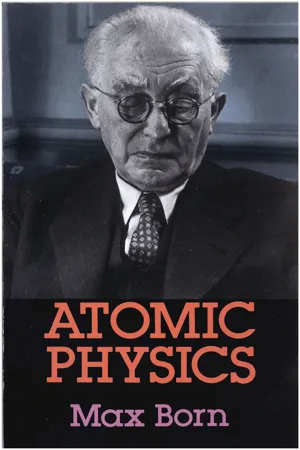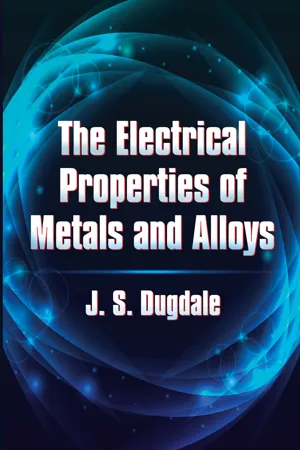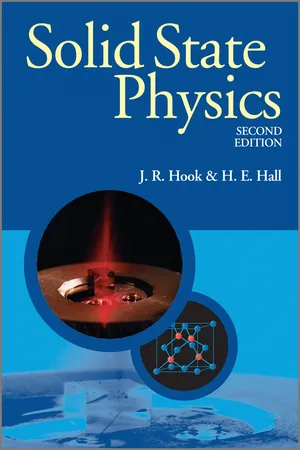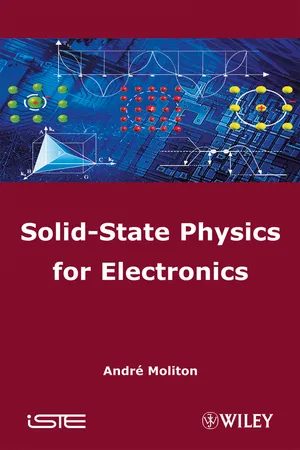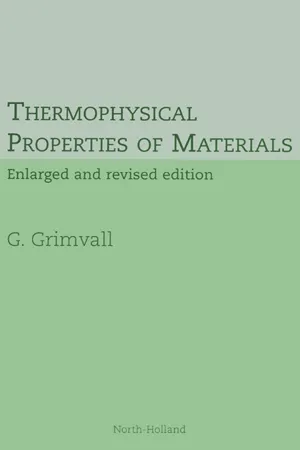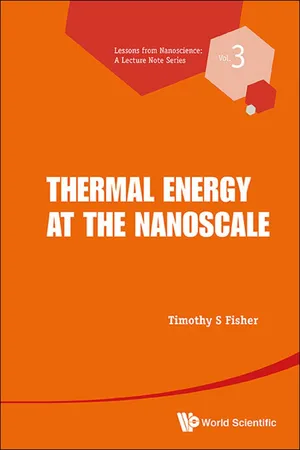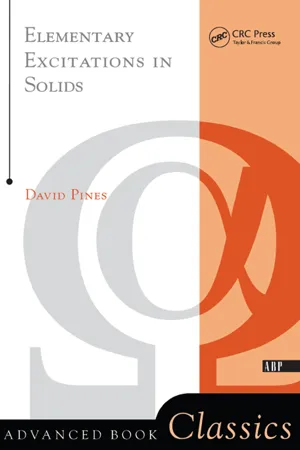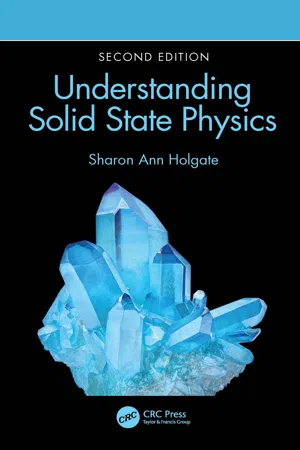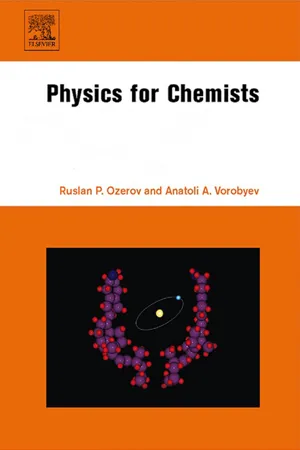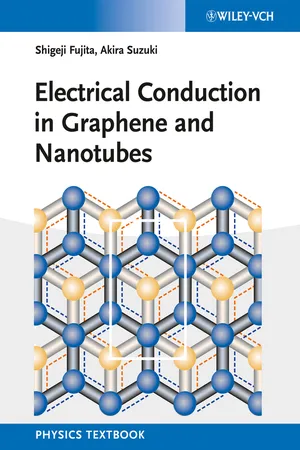Physics
Lattice Vibration
Lattice vibration refers to the collective oscillations of atoms within a crystalline structure. These vibrations propagate as waves through the lattice, influencing the material's thermal and mechanical properties. Understanding lattice vibrations is crucial in the study of materials science and solid-state physics, as they play a fundamental role in determining a material's behavior and properties.
Written by Perlego with AI-assistance
Related key terms
Related key terms
1 of 4
Related key terms
1 of 3
12 Key excerpts on "Lattice Vibration"
- Pascal Richet, Pascal Richet(Authors)
- 2021(Publication Date)
- Wiley-American Ceramic Society(Publisher)
3.4 Atomic Vibrations in GlassesBernard Hehlen and Benoît RuffléLaboratoire Charles Coulomb (L2C), UMR 5221 CNRS, Université de Montpellier, Montpellier, France1 Introduction
Atoms have by definition essentially fixed position in a solid. Their only degrees of freedom are thus vibrations around these positions with amplitudes that increase with temperature. As a thermodynamic measure of these changes, the heat capacity then determines the temperature dependence of the internal energy, entropy, and other functions. But the relevance of atomic vibrations is not restricted to thermal properties because thermal energy is involved in any process where potential energy barriers must be overcome. This is the case of not only any kind of phase transformations, including magnetic or ferroelectric transitions, but also of transport of heat, electrically charged species, or atoms.In a crystal, atoms do not vibrate independently from one another. Vibrations are instead described as a set of harmonic plane waves termed phonons whose energies are quantized, whose number and type are determined by the symmetry of the lattice, and whose frequencies vary with the wave vectors according to specific dispersion relations. Although the fundamental basis of lattice dynamics was laid down by Born and von Karman as early as 1912, the lack of spatial symmetry prevents this theory from being applied to amorphous solids. The problem of atomic vibrations in glasses has thus long been laid aside until the impressive development of new experimental techniques, computing capabilities, and theoretical advances has made it possible to tackle it fruitfully in the last past decades.The connection between the macroscopic and microscopic aspects of atomic vibrations is most readily established through the vibrational density of states, g(Ω), which is the distribution of the number of vibrational modes as a function of the frequency Ω. The vibrational isochoric heat capacity Cv (T) is directly derived from g- eBook - ePub
- Max Born(Author)
- 2013(Publication Date)
- Dover Publications(Publisher)
fig. 2 , which represents the spectrum of Lattice Vibrations in a crystal containing two atoms or ions in the unit cell. The details of scale and shape vary of course from crystal to crystal, and the diagram does not tell us how the relative displacements of the two atoms change in going from the acoustic modes of long wave-length to the modes with wave numbers at the edge of the zone and lastly to the high-frequency optical modes.Fig. 2.—The vibrational spectrum of a diatomic linear chain.3. Quantisation of the Lattice Vibrations.So far we have made no reference to wave mechanics in discussing the Lattice Vibrations and their frequencies, but have worked in effect with a collection of classical particles coupled by linear elastic forces. Just as for a simple harmonic oscillator, the effect of wave mechanics is to quantize the energy, so that the possible energies of the crystal mode with wave number are (n + )hv , where v is the corresponding frequency and n can take the integer values 0, 1, 2. . . .The total energy of Lattice Vibration is thenwhere E0 is the zero-point energy of the nuclear motions. The statistical mechanics of the Lattice Vibrations is now very easy, since we can take over the results for Bose–Einstein statistics which were obtained in Chap. VII, § 4 - eBook - ePub
Foundations of Solid State Physics
Dimensionality and Symmetry
- Siegmar Roth, David Carroll(Authors)
- 2019(Publication Date)
- Wiley-VCH(Publisher)
θ term over a sphere. This yields5.7If we allow for the motion of the atom to be nearly harmonic, then we get Structure Factor terms with the form5.8and the intensity of the scattered radiation from the square of this becomes5.9Here, I0 is the scattering intensity from a static lattice. So there is an X‐ray intensity drop‐off. Part of this comes with the increasing angle of G and part from the Debye–Waller factor. Of course, for the case of neutron diffraction, the drop‐off is entirely due to the Debye–Waller term, as you will understand by the last section of the chapter.Thus, it would seem that we must include “the motion of things” within our picture of the lattice, even in regimes far from melting. But in this chapter we must do more than this and introduce a powerful new idea for phenomena from diffraction to specific heat, speed of sound, thermal and electrical conductivity, thermoelectricity, and more. What is this idea? The atoms of the lattice move as elastic, vibrational waves! In other words the atomic motion within the solid is correlated. This fascinating concept must be reasoned through a circuitous route:- Introduce a classical model to explain the atomic correlation.
- Examine the role of dimension in the dynamics expressions of the modes of vibration.
- Discuss the modifications of our classical picture that are introduced through quantum mechanics.
- Make the connection between classical elastic vibrational modes and phonon quasiparticles.
- Introduce the statistics of phonons.
- Calculate thermodynamic entities on the basis of phonon models.
5.1 Crystal Vibrations and Phonons
The arrangement of atoms or molecules into a crystal is a result of forces that keep the atoms in their positions. These forces are due to the chemical bonding between atoms. Now, this is a quantum system so we really should talk about potentials and wavefunctions, but first let's look at the implications of a purely classical model. And the most famous classical model is to represent each bond as Hooke spring (Figure 5.1 - eBook - ePub
- J.S. Dugdale(Author)
- 2016(Publication Date)
- Dover Publications(Publisher)
8Scattering (2): Lattice VibrationsHaving learned something about scattering by static imperfections in the lattice, let us now turn our attention to scattering of electrons by Lattice Vibrations. If the lattice vibrates, there exist in the lattice periodic variations in density and hence in potential in addition to the fundamental periodicities that characterizes the static lattice. Consequently, the electron states which were the stationary quantum states associated with the static periodic lattice will be perturbed by the Lattice Vibrations; in other words, these vibrations will induce transitions of the electrons among the k-states and so cause them to be scattered.8.1The geometry of scatteringWhen an electron moves through a vibrating lattice it may either absorb or emit quanta of vibrational energy. In the process its energy and wavevector will change. Consider, for example, an electron of wavevector k and energy Ek and suppose that it interacts with vibrations of wavevector q and frequency ω. The interactions that are most frequent are those that involve a single phonon. In such a process, the energy balance requires that if Ek′is the energy of the electron after it has made a transition to the state, k′, thenIf we take the positive sign, the energy of the electron is increased by the process, i.e. the phonon is absorbed. If we take the negative sign, the energy of the electron is decreased, i.e. the phonon is emitted.Now let us look at some typical magnitudes involved in Equ. 8.1 . In terms of a Debye solid with characteristic temperature θD , the phonons excited at low temperatures (T ≪ θ ) rarely have energies in excess of kT, so that at these temperatures ℏ ω ≲ kT. At high temperature (T > θD ), however, the energy of the phonons cannot exceed hωmax which by definition is kθD - eBook - ePub
- J. R. Hook, H. E. Hall(Authors)
- 2013(Publication Date)
- Wiley(Publisher)
11In performing the calculationsEeis normally taken to be the ground state energy of the electrons although Eq. (2.22) holds also for an excited state. The nuclear motions are not in general significantly affected by the existence of excited electronic states.2.5 PHONONS
So far we have considered the mechanics of Lattice Vibrations in a completely classical way. To the extent that the normal modes we have found are truly harmonic and independent, the transition to quantum mechanics is easily made by supposing that a Lattice Vibration mode of frequency ω will behave like a simple harmonic oscillator and will thus be restricted to energy values(2.23)Since Eq. (2.23) represents a set of uniformly spaced energy levels, it is possible to regard the state εn as constructed by adding n ‘excitation quanta’ each of energy ω to the ground state. You may already have met this viewpoint in the context of electromagnetic radiation of angular frequency ω ; there we say that the state εn corresponds to the presence of n photons each of energy ω . The reality of such energy-carrying particles is shown, for example, in the photoelectric effect.It is often convenient to treat Lattice Vibrations in an analogous way, and to introduce the concept of phonons of energy ω as quanta of excitation of the Lattice Vibration mode of angular frequency ω . Our normal modes are plane waves extending throughout the crystal, and correspondingly the phonons are not localized particles; the uncertainty principle demands that the position cannot be determined because the momentum k is exact. However, just as with photons or electrons, one can construct a fairly localized wavepacket by combining modes of slightly different frequency and wavelength. Thus, if we take waves with a spread of k of order π 10a we can make a wavepacket localized to within about 10 unit cells. Such a wavepacket represents a fairly localized phonon moving with group velocity dω dk. We can therefore treat phonons as localized particles within the limits of the uncertainty principle. The ω (k ) curve for Lattice Vibrations can be interpreted, if both axes are multiplied by , as a relation between energy and momentum for phonons (E = ω , p = k - eBook - ePub
- Andre Moliton(Author)
- 2013(Publication Date)
- Wiley-ISTE(Publisher)
There are other quasi-particles that can be present. These include polaritons, that describe the transverse optical coupled modes of photons and phonons, magnons, that describe systems based on coupled spin moments, and solitons that correspond to a default in the conformation of a chain of atoms that may or may not be coupled to a charge. However, this text will detail only the main types of quasi-particles.10.2. Lattice Vibrations: phonons10.2.1. Introduction
With the bonding forces between atoms being finite, an external perturbation such as thermal energy can result in atoms being distanced from the equilibrium position.In this example the forces and atomic displacements are directed along r . With F (r ) denoting the bonding force on an atom at r with the corresponding potential energy W (r ), then:If r 0 represents the equilibrium position of an atom (located with respect to the origin of the displacements), and if Δr denotes the displacement that is such that r = r 0 + Δr , we can write that:(as the first derivative is zero with respect to r 0 where W (r ) is a minimum and an equilibrium position). The result is:and we have Hooke’s law. With dr = d (Δr ), the fundamental dynamic equation is written as:for which the physical solution is of the form:where . This represents the sinusoidal oscillatory movement with frequency v .In a crystalline system it is no longer a single atom that vibrates but rather a set of atoms and a coupling between the vibrations. This is because the vibrations of atoms will affect those of neighboring atoms.If we have a system with N atoms, and each atom has three degrees of freedom, then the vibrational system will have 3N waves with different frequencies (normal vibrations). The movement of each atom is determined by the superposition of the 3N waves (or 3N - eBook - ePub
- G. Grimvall(Author)
- 1999(Publication Date)
- North Holland(Publisher)
CHAPTER 7THERMAL PROPERTIES OF HARMONIC Lattice VibrationS
1 Introduction
Lattice Vibrations give the key to many temperature dependent properties of solids. If we know the quantum mechanical energy eigenvalues of these vibrations, we can easily model thermodynamic quantities such as the Gibbs energy and the heat capacity. If we also know the eigenfunctions corresponding to the eigenvalues, we can calculate, e.g. the vibrational displacements of the atoms and connect that to properties such as the electrical resistivity. In applications to materials science the temperature is often so high that a classical description agrees very well with the more fundamental quantum mechanical approach. We therefore start with a brief comparison of these two descriptions.Consider a one-dimensional oscillator in classical mechanics. If the restoring force constant is k , and the mass is M , the frequency is(7.1)The potential energy E pot is(7.2)The equipartition theorem says that, in thermal equilibrium, the potential energy and and the kinetic energy are equal;(7.3)Here “ − ” denotes thermal average. It follows that the thermally averaged squared displacement is(7.4)The heat capacity C = ∂E/∂T is(7.5)The absolute value of the Helmholtz (free) energy F = E − TS is undefined since classical physics only deals with entropy differences and not their absolute values.These classical properties can be contrasted with the quantum mechanical description. There the Helmholtz energy can be obtained as(7.6)Z is the partition function, containing a sum over all quantum states i with energiesEi;(7.7)In our case with a single oscillator, the quantum energies are with n = 0, 1, 2, 3, …, and Z takes a simple closed form;(7.8)which yields(7.9)From a knowledge of F = E − TS , ordinary thermodynamics gives, e.g. the energy E and the entropy S. The third law of thermodynamics implies that S = 0 at T = 0 K, and the entropy has a well-defined value. There is also an “equipartition” theorem for each quantum state of a harmonic oscillator, saying that the expectation values and of the potential and kinetic parts of the Hamiltonian H - eBook - ePub
- Timothy S Fisher(Author)
- 2013(Publication Date)
- WSPC(Publisher)
The study of thermal energy in any material should rightly begin with a description of the material itself, for thermal energy, unlike other forms of energy such as optical, electronic, and magnetic, is routinely generated, stored, and transported by a diverse set of ‘carriers’. The reason for broader context of thermal energy derives from the second law of thermodynamics, which dictates that all forms of energy tend toward disorder (or ‘thermalization’). In this text, we will make every reasonable attempt to unify the analysis, i.e., to generalize concepts so that they apply to multiple carriers, but this objective is occasionally elusive. In such cases, the text will make clear the relevant restrictions by carrier and material types. The list of interesting materials and physical structures is almost endless, and therefore given the subject of ‘nanoscale’ physics, the text begins with an admittedly cursory treatment of interatomic bonding but then highlights where possible a compelling structure — the graphene carbon lattice — to illustrate important and unique thermal behavior at the nanoscale.1.2 Atom-to-Atom Bonding in Solid LatticesThe details of interatomic bonding determine a broad assortment of physical material properties, ranging from mechanical strength to electrical conductivity. The primary interest here relates to the resultant vibrational characteristics of atoms that exist in an ordered arrangement, i.e., in a regular crystal. However, we start with a simpler situation: that of a diatomic molecule.Figure 1.2 shows a schematic of two atoms separated by an equilibrium distance r = r0 about which the atoms vibrate at various (but restricted) frequencies. A generic potential energy field U(r) between the atoms is shown in the bottom half of the figure, revealing the strong repulsive force (F = –∂U/∂r) when the atoms are close together (r < r0 ). The minimum energy (at r = r0 ) corresponds to the bond energy, as the potential energy asymptotes to zero when the atoms are pulled apart (r - eBook - ePub
- David Pines(Author)
- 2018(Publication Date)
- CRC Press(Publisher)
Chapter 2 PHONONS 2-1 LATTICE DYNAMICS IN ONE DIMENSION Lattice-Wave Dispersion RelationWe begin our study of phonons with a brief review of lattice dynamics and the quantization of the phonon field. It is recommended to the reader who is unfamiliar with these topics that he consult one of the standard texts (Peierls1 or Ziman,2 for example) where more of the mathematical details and physical discussion may be found.Because we are here interested primarily in lattice motion, we shall restrict our attention to that part of the general Hamiltonian, (1-4 ), which involves ion motion only, Hion . We return later (in Chapter 5 ) to a discussion of the coupled motion of ions and electrons in metals.Most of the salient features of phonons may be understood from a study of a one-dimensional solid, i.e., a linear atomic array. For that reason, we begin our review there, and consider the appropriate three-dimensional generalization in a subsequent section.The simplest linear crystal structure for similar ions is one of equal spacing. The equilibrium position of the nth ion is denoted by Rno . Obviously, we have Rno = na, where a is the interionic spacing. The actual position (under vibrations) of the nth ion is Rn . Defining δRn as the departure from equilibrium of the nth ion, we obtain
For our one-dimensional solid, the Hamiltonian of the system isR n=R no+ δR n(2-1) H =∑ i+P i22 M1 2∑i ≠ jV()R i−R j(2-2) where Ri and Pi are the position and momentum of the ith ion.One assumes that the displacement from equilibrium of the ions is small, so that one can expand any quantity involving Rn , say, as a Taylor series in δRn . Thus one expands V(Ri − Rj ) in a Taylor series about the equilibrium separation Rio − Rjo . Retaining up to the quadratic terms in δRi , we may write (2-2 - eBook - ePub
- Sharon Ann Holgate(Author)
- 2021(Publication Date)
- CRC Press(Publisher)
zero-point motion, and the kinetic energy possessed by atoms with zero-point motion is termed “zero-point energy”.If an atom is considered individually, its motion about its own lattice point is approximately the same as that of simple harmonic motion (SHM). However, atoms cannot vibrate independently of each other because they are connected together by bonds. So any vibration in one atom gets passed on to its neighbours, which in turn pass the vibration on to their neighbours, and so on, producing a vibratory wave that passes through the solid.Longitudinal and Transverse Waves in Solids
One way of thinking about the atoms in a crystal is as a collection of balls linked by springs, where the balls represent the atoms and the springs represent the bonds as illustrated in Figure 5.8 .FIGURE 5.8 A representation of a one-dimensional chain of atoms linked by atomic bonds.There are two ways in which an elastic wave—in other words, a wave that travels along because of the vibration of the particles of the material it is in—can be set up in a one-dimensional layer of atoms like the one shown in Figure 5.8 . One is for two balls to be moved further apart and then allowed to bounce back together again in a horizontal direction (see Figure 5.9 ). This is what occurs when a crystal is subject to a sudden impact, or when a particular area of a crystal is heated. In the latter case, the expansion in the heated region causes the atoms to move further apart, then they move back together again as they cool. As a result of this motion, a longitudinal wave is created that travels through the solid. The movement is passed from one neighbour to another in a knock-on effect because they are all linked by bonds. So longitudinal waves (such as sound waves) are vibrational waves moving along the same direction as the vibration making up the wave. (See Appendix B - eBook - ePub
- Ruslan P. Ozerov, Anatoli A. Vorobyev(Authors)
- 2007(Publication Date)
- Elsevier Science(Publisher)
collective excitations . Hence, in modern terminology, lattice heat capacity is a development of collective excitation in solids, i.e., the heat energy goes to phonon excitation (see below).Participation of electron excitations in heat capacity is limited by quantum statistics laws (refer to Section 9.2.2 ). As only a small part of the electrons takes part in excitation, the electronic heat capacity usually makes a very small addition in comparison with the lattice one.In a polycrystalline sample consisting of a large number of microcrystals, ideally—randomly dispersed in space—the resulting picture is averaged. As a result, the function g (ω ), presents the projection of all dispersion branches to the axis of frequencies (phonon spectrum). It describes the distribution of oscillations on frequencies: product g (ω )dω gives the number of oscillations dz falling on an interval dω . In Figure 9.19 the experimentally measured function g (ω ) for aluminum is given as an example.The fluctuation distribution function determines the internal energy of a crystal:U = ∫(9.3.7)ɛ ¯g( ω )d ω ,(9.3.7)whereɛ ¯is an averaged oscillation energy.The dispersion curves and g (ω ) function can be obtained by neutron scattering methods.9.3.2 The heat capacity of crystals
Heat capacity was introduced in Section 3.4.3 as the heat energy capable of heating a body by 1 grad. For an ideal gas in molecular kinetic theory the mole heat capacity appeared to be equal toC V=R andi ef2C p=R ,2i ef+ 2where i ef is the effective number of a gas molecule’s degrees of freedom. In this case i ef turns out to be the sum of translational, rotational and oscillation movements; in the latter i ef, osc = 2 because oscillation simultaneously possesses potential and kinetic energy.Apply these representations to a solid. For this purpose we should first analyze the character of possible movements of the molecules in it. Clearly, translational motion is excluded in this case. The rotation of molecules in a crystal is basically possible. For example, in crystal NH4 Cl a group NH4 + - eBook - ePub
- Shigeji Fujita, Akira Suzuki(Authors)
- 2013(Publication Date)
- Wiley-VCH(Publisher)
Chapter 4
Phonons and Electron–Phonon Interaction
Phonons, electron–phonon interaction, and the phonon-exchange attraction are discussed in this chapter.4.1 Phonons and Lattice Dynamics
In the present section, we review a general theory of heat capacity based on lattice dynamics.Let us take a crystal composed of N atoms. The potential energy depends on the configuration of N atoms located at (r1 , r2 , ···, rN). We regard this energy as a function of the displacements of the atoms,(4.1)measured from the equilibrium positions rLet us Taylor expand the potentialj(0) .in terms of small displacements {ujμ}:(4.2)where all partial derivatives are evaluated at u1 = u2 = ··· = 0, which is indicated by subscript 0. We may set the constant 0 equal to zero with no loss of rigor. By assumption, the lattice is stable at the equilibrium configuration. Then the potential must be at a minimum, requiring that the first-order derivatives vanish:(4.3)For small oscillations we may keep terms of the second order in ujμonly. We then have(4.4)where(4.5)The prime (’) on indicating the harmonic approximation, will be dropped hereafter. The kinetic energy of the system is given by(4.6)The kinetic energy of all the atoms is the sum of their individual kinetic energies.We can now write down the Lagrangian ≡ − as(4.7)The Lagrangian in the harmonic approximation is quadratic in ujμandjμ. According to the theory of principal-axis transformation [1], we can in principle transform the Hamiltonian (total energy) = + for the system into the sum of the energies of the normal modes of oscillations:(4.8)where {Qκ , Pκ } are the normal coordinates and momenta, and ωκ are characteristic frequencies. We note that there are exactly 3 N normal modes.Let us first calculate the heat capacity by means of classical statistical mechanics. This Hamiltonian is quadratic in canonical variables (Qκ , Pκ ). Hence, the equipartition theorem holds. We multiply the average thermal energy kB T for each mode by the number of modes 3N and obtain 3N kB T for the average energy . Differentiating this with respect to T, we obtain 3NkB for the heat capacity, in agreement with Dulong–Petit’s law. It is interesting to observe that we obtained this result without knowing the actual distribution of normal-mode frequencies. The fact that there are 3 N
Index pages curate the most relevant extracts from our library of academic textbooks. They’ve been created using an in-house natural language model (NLM), each adding context and meaning to key research topics.
Explore more topic indexes
Explore more topic indexes
1 of 6
Explore more topic indexes
1 of 4

